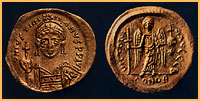|
The Early Byzantine coins and seals
Early Byzantine coins were minted in gold, silver
and copper alloys, the  most
common of them being the gold coin, known as the solidus (or
nomisma in Greek), and a variety of denominations of copper,
namely the follis and its fractions, which were used in every
day transactions. The typical Early Byzantine solidus bears
an image of the reigning emperor on the obverse. This is usually
a bust, with an inscription giving the emperor's name and
titles. A co-emperor (a son or brother), a seated figure of
Constantinople, an angel or a Victory carrying a cross or
a cross on steps, are occasionally shown on the reverse (religious
figures, such as the Virgin and Christ become more common
in the Middle Byzantine period). Style and iconography similar
to that of coinage is found on the seals, usually made of
lead, that were used to authenticate important documents by
emperors, as well as religious and state officials. Here,
the abbreviated name (monogram) of the person issuing the
seal is present on the obverse. most
common of them being the gold coin, known as the solidus (or
nomisma in Greek), and a variety of denominations of copper,
namely the follis and its fractions, which were used in every
day transactions. The typical Early Byzantine solidus bears
an image of the reigning emperor on the obverse. This is usually
a bust, with an inscription giving the emperor's name and
titles. A co-emperor (a son or brother), a seated figure of
Constantinople, an angel or a Victory carrying a cross or
a cross on steps, are occasionally shown on the reverse (religious
figures, such as the Virgin and Christ become more common
in the Middle Byzantine period). Style and iconography similar
to that of coinage is found on the seals, usually made of
lead, that were used to authenticate important documents by
emperors, as well as religious and state officials. Here,
the abbreviated name (monogram) of the person issuing the
seal is present on the obverse.
|